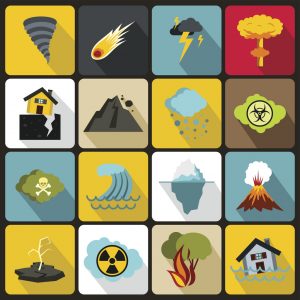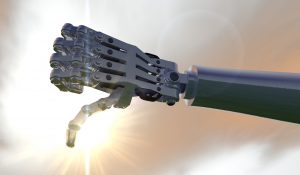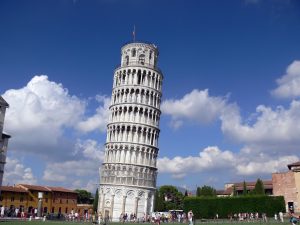Volcanoes, hurricanes, and polar vortexes—oh, my! From the ongoing eruption of the Kilauea volcano in Hawaii, to huge winter storms, massive mudslides, and the unfortunately reliable hurricane season, it seems like natural disasters have been near constant over the past year. In addition to the catastrophic toll these events take on people and communities, the toll on a business can be high. Understanding the full range and implications of your company’s risks, and putting the right coverage in place to protect against those risks, is vital. When a natural disaster strikes, having appropriate levels of property damage, business interruption and contingent business interruption insurance can be three keys to stability.
season, it seems like natural disasters have been near constant over the past year. In addition to the catastrophic toll these events take on people and communities, the toll on a business can be high. Understanding the full range and implications of your company’s risks, and putting the right coverage in place to protect against those risks, is vital. When a natural disaster strikes, having appropriate levels of property damage, business interruption and contingent business interruption insurance can be three keys to stability.
Articles Posted in Business Interruption
Artificial Intelligence: A Grayish Area for Insurance Coverage
 Artificial Intelligence (AI) is a hot topic in industries from manufacturing to the medical profession. Developments in the last ten years have delivered AI technology, once a fiction reserved for the movies, to private corporations and even to everyday homes. Examples include:
Artificial Intelligence (AI) is a hot topic in industries from manufacturing to the medical profession. Developments in the last ten years have delivered AI technology, once a fiction reserved for the movies, to private corporations and even to everyday homes. Examples include:
- 2004 Defense Advanced Research Projects Agency (DARPA) sponsors a driverless car grand challenge. Technology developed by the participants eventually allows Google to develop a driverless automobile and modify existing transportation laws.
- 2005 Honda’s ASIMO humanoid robot can walk as fast as a human, delivering trays to customers in a restaurant setting. The same technology is now used in military robots.
- 2011 IBM’s Watson wins Jeopardy against top human champions. It is training to provide medical advice to doctors. It can master any domain of knowledge.
- 2012 Google releases its Knowledge Graph, a semantic search knowledge base, likely to be the first step toward true artificial intelligence.
- 2013 BRAIN initiative aimed at reverse engineering the human brain receives $3 billion in funding by the White House, following an earlier billion euro European initiative to accomplish the same.
- 2014 Chatbot convinced 33% of the judges it was human and by doing so passed a restricted version of a Turing Test.
Not Quite So Limited: Are Sublimits Sure to Limit Your Level of Coverage?
A critical component of any insurance policy is of course its limit, which is usually the most an insurance company must pay for a loss. But many property insurance policies include “sublimits” that provide a lower limit for particular losses.
 Identifying the sublimits in a policy is usually straightforward since they typically appear in a list or chart in the policy’s declarations section. Sublimits generally fall into one of two types: (1) sublimits that apply to particular perils, like flood, Named Storm or earthquake; and (2) sublimits that apply to a type of damage or cost, like debris removal or preservation of property. There are many different perils and costs that a policy may sublimit, and sublimits appear in many types of policies (including, for example, sublimits for coverage for wage and hour claims under an employment liability policy). However, this blog will focus on property policy sublimits. Because many property policies include sublimits that apply to storm-related losses, they may particularly be an issue for companies damaged by hurricanes like 2017’s Harvey, Irma, Jose and Maria.
Identifying the sublimits in a policy is usually straightforward since they typically appear in a list or chart in the policy’s declarations section. Sublimits generally fall into one of two types: (1) sublimits that apply to particular perils, like flood, Named Storm or earthquake; and (2) sublimits that apply to a type of damage or cost, like debris removal or preservation of property. There are many different perils and costs that a policy may sublimit, and sublimits appear in many types of policies (including, for example, sublimits for coverage for wage and hour claims under an employment liability policy). However, this blog will focus on property policy sublimits. Because many property policies include sublimits that apply to storm-related losses, they may particularly be an issue for companies damaged by hurricanes like 2017’s Harvey, Irma, Jose and Maria.
Understanding Business Interruption Insurance and Wide-Impact Catastrophes
In the wake of Hurricanes Harvey and Irma, policyholders can expect insurers to put forward strong objections to some of the most consequential claims asserted by insureds. In a recent client alert, our colleagues Joe Jean and Vince Morgan provided insight into business interruption insurance and dealing with the aftermath of wide-impact catastrophes.
Hurricane Harvey and Irma: Is Your Company Prepared for a Disaster?
An unexpected or catastrophic loss can force any company out of business, even if it is insured. You must understand your company’s risks and how your insurance policies cover those risks in order to manage them and maintain stability.
Having the correct insurance in place is only the first step. Property and business interruption insurance policies are often complex, and your suppliers, customers and other business partners’ insurance situation may have a direct impact on you as well. Even if your business doesn’t suffer any direct physical damage to its facilities following a natural disaster or other loss, your customers or suppliers may have, and that could result in what is known as a “supply chain” or “contingent business interruption” loss of revenue and sales. If you are unprepared when a disaster strikes, you may miss out on substantial amounts of insurance coverage to which you may be entitled. The time to prepare is before a disaster occurs. Take the time now to understand your insurance coverage and other risk transfer methods and opportunities. Know your rights. And put a plan in place to protect yourself, your employees, and your property before the loss occurs. Then, if disaster strikes, you’ll be in a better position to make it through and to access your insurance coverage to help restore operations.
Hurricane Harvey: Insurance Implications
As the powerful storm that is Hurricane Harvey looms in the Gulf of Mexico, Houston attorneys Vince Morgan and Tamara Bruno discuss what businesses and other organizations in the affected area should do immediately in order to maximize insurance recovery.
Key Takeaways:
-
- Category 3 Hurricane Harvey is projected to have sustained winds of 120 m.p.h. and disastrous amounts of rain, with a possible storm surge.
-
- Business interruptions are already happening in advance of Harvey’s landfall.
- Policyholders should take key steps to maintain and maximize insurance coverage for Harvey-related losses.
Who Cares about an Oxford Comma? A Maine Dairy Receives a $10 Million Lesson in Grammar and Ambiguity
A panda is sitting in a bar, polishing off his dinner. He pulls out a gun, fires a shot in the air, and heads toward the exit. A stunned waiter demands an explanation. The panda pauses at the door and tosses the waiter a badly punctuated wildlife manual. “I’m a panda—look it up.” The waiter turns to the appropriate entry: “Panda. Large black-and-white bear-like mammal, native to China. Eats, shoots and leaves.” [1]

Beware the missing Oxford comma!
That was the lesson of a recent decision by the First Circuit Court of Appeals, which held that the omission of an Oxford comma in a Maine employment statute created an ambiguity that must be resolved in favor of dairy delivery drivers. For want of a comma, the dairy is out $10 million.
Coverage for Legal Marijuana Risk: Seeing through the Smoke and Mirrors
We’ve come a long way since the days of Timothy Leary—both in terms of marijuana legalization, and in the diversity of business insurance products that have reached the market to insure marijuana-related risks. As of this blog post, more than 20 states have legalized marijuana for medical use, including eight states that have also legalized it recreationally. At the federal level, however, marijuana continues to be a Schedule I controlled substance, making it illegal for any purpose. Whether and to what extent the federal prohibition will be enforced by the Trump administration is not yet known. As the legal marijuana industry continues to grow apace, industry participants would do well to consider the insurance products available to them and potential pitfalls for the unwary.

Are You Prepared for the Leaning Tower of … San Francisco?
In 1173, builders broke ground in Pisa, Italy, on the Torre de Pisa (that is, the Tower of Pisa). At over 183 feet, it was to be a grand statement—remember, this was 1173, not 2016.

But the story is not all roses. The tower began immediately to tilt—by the time they started laying just the second floor of the tower, it was leaning. Thus, it earned the name we all now know (and love?), “Torre pendent di Pisa”—the Leaning Tower of Pisa. Wikipedia explains, “[t]he tower’s tilt began during construction, caused by an inadequate foundation on ground too soft on one side to properly support the structure’s weight. The tilt increased in the decades before the structure was completed, and gradually increased until the structure was stabilized (and the tilt partially corrected) by efforts in the late 20th and early 21st centuries.” The tower now leans over 12 feet from the vertical axis.
Hurricane Matthew Requires Immediate Action to Maximize Insurance Recovery
After tearing through the Caribbean, Hurricane Matthew’s path brought it north to the southeastern coast of the United States, bringing evacuations, business closures and damages to the region. In the storm’s aftermath, colleagues Tamara Bruno, Colin Kemp, Peter Gillon, Vince Morgan and Joe Jean discuss important steps to take to maximize insurance recovery following such an event.
 Policyholder Pulse
Policyholder Pulse


